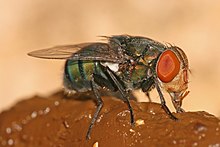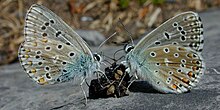This is an old revision of this page, as edited by DrChrissy (talk | contribs) at 20:28, 26 February 2015 (→Invertebrates: expand + ref). The present address (URL) is a permanent link to this revision, which may differ significantly from the current revision.
Revision as of 20:28, 26 February 2015 by DrChrissy (talk | contribs) (→Invertebrates: expand + ref)(diff) ← Previous revision | Latest revision (diff) | Newer revision → (diff) Not to be confused with Coprographia.
Coprophagia /kɒp.rə.ˈfeɪ.dʒi.ə/ or coprophagy /kəˈprɒfədʒiː/ is the consumption of feces. The word is derived from the Greek κόπρος copros, "feces" and φαγεῖν phagein, "to eat". Many animal species eat feces as a normal behavior; other species may not normally consume feces but do so under very unusual conditions. Coprophagy refers to many kinds of feces eating including eating feces of other species (heterospecifics), of other individuals (allocoprophagy), or its own (autocoprophagy), those once deposited or taken directly from the anus.
In animals
Invertebrates


Coprophagous insects consume and redigest the feces of large animals. These feces contain substantial amounts of semi-digested food (herbivores' digestive systems are especially inefficient). A notable feces-eating insect is the dung-beetle and possibly the most common is the fly.
Termites eat one another's feces as a means of obtaining their hindgut protists. Termites and protists have a symbiotic relationship (e.g. with the protozoan that allows the termites to digest the cellulose in their diet via the protists. For example, in one group of termites, there is a three-way symbiotic relationship - termites of the family Rhinotermitidae, cellulolytic protists of the genus Pseudotrichonympha in the guts of these termites, and intracellular bacterial symbionts of the protists.
Vertebrates
Domesticated and wild mammals are known to consume feces. In the wild they either bury or eat waste to protect their trail from predators. Mother cats are known to eat the feces of their newborn kittens during the earliest phase after birth, presumably to eliminate cues to potential predators and to keep the den clean.
Hamsters, guinea pigs, chinchillas and naked mole-rat eat their own droppings, which are thought to be a source of vitamins B and K, produced by gut bacteria. Gorillas and chimpanzees eat their own feces and the feces of other gorillas and chimpanzees. This may serve to improve absorption of vitamins or of nutritive elements made available from the re-ingestion of seeds. Apes have been observed eating horse feces for the salt content. Monkeys have been observed eating elephant feces.
Pigs sometimes eat the feces of herbivores that leave a significant amount of semi-digested matter, including their own. In some cultures, it was common for poor families to collect horse feces to feed their pigs, which contributes to the risk of parasite infection. The pig toilet is an ancient method of feeding pigs on garbage and human feces, and is used in China.
Capybara, rabbits, and some other related species are hindgut fermenters which digest cellulose by microbial fermentation. In addition, they extract further nutrition from grass by ingesting their feces meaning their food passes through the gut a second time. Soft fecal pellets of partially digested food are excreted and generally consumed immediately. Consuming these cecotropes (or night feces produced in the cecum), is important for obtaining vitamin B12, which intestinal bacteria produce from Cobalt salts. Vitamin B12 must then be re-introduced to the digestive system since only the stomach (and not the intestines) is capable of absorbing vitamin B12. They also produce normal droppings, which are not eaten.
Cattle in the United States are often fed chicken litter due to the high amount of protein and low cost of the feed compared to other sources of protein. It has been reported that this process is made safe in regards to bacteria loading by heating the chicken litter to 160 °F (71 °C) prior to consumption. There are, however, concerns that the practice of feeding chicken litter to cattle could lead to bovine spongiform encephalopathy (mad-cow disease) because of the crushed bone meal in chicken feed. The U.S. Food and Drug Administration regulates this practice by attempting to prevent the introduction of any part of a cow's brain or spinal cord into livestock feed. Other countries, like Canada, have banned chicken litter for use as a livestock feed.
The young of elephants, pandas, koalas, and hippos eat the feces of their mothers or other animals in the herd to obtain the bacteria required to properly digest vegetation found on their ecosystems. When they are born, their intestines do not contain these bacteria, they are sterile. Without them, they would be unable to obtain any nutritional value from plants.
Humans
- In medicine
Fecal bacteriotherapy is when feces from a close relative or spouse are given to patients suffering from intractable diarrhea caused by Clostridium difficile. The objective is to repopulate the intestines with the normal gut flora (intestinal bacteria) which kill the clostridium. The healthy stool is administered by nasogastric tube, enema, or in a capsule.
| This article needs additional citations for verification. Please help improve this article by adding citations to reliable sources. Unsourced material may be challenged and removed. Find sources: "Coprophagia" – news · newspapers · books · scholar · JSTOR (February 2015) (Learn how and when to remove this message) |
Consuming other people's feces carries the risk of contracting diseases and bacteria spread such as E. coli, Hepatitis A, Hepatitis E, pneumonia, polio, and influenza. Coprophagia also carries a risk of contracting intestinal parasites.
| This article needs additional citations for verification. Please help improve this article by adding citations to reliable sources. Unsourced material may be challenged and removed. Find sources: "Coprophagia" – news · newspapers · books · scholar · JSTOR (February 2015) (Learn how and when to remove this message) |
Lewin reported that "... consumption of fresh, warm camel feces has been recommended by Bedouins as a remedy for bacterial dysentery; its efficacy (probably attributable to the antibiotic subtilisin from Bacillus subtilis) was anecdotally confirmed by German soldiers in Africa during World War II".
Coprophagia has been observed in a small number of patients with schizophrenia, depression, and pica.
Centuries ago, physicians tasted their patients' feces, to better judge their state and condition.
- In sex
Coprophagia is depicted in pornography, usually under the term scat (from scatology).
- In literature
- The 120 Days of Sodom, a novel by the Marquis de Sade written in 1785, is replete with detailed descriptions of erotic sadomasochistic coprophagia.
- Thomas Pynchon's award winning 1973 novel Gravity's Rainbow contains a detailed scene of coprophagia.
- François Rabelais, in his classic Gargantua and Pantagruel, often employs the expression mâche-merde or mâchemerde, meaning shit-chewer. It is in turn a citation of the Greek comedians Aristophanes and particularly Menander, which often use the term skatophagos (σκατοϕάγος). In one dialogue, Rabelais speaks of coprophagia as a Christian gesture, saying that monks swallow the shit of the world, that is the sins, and for this they are ostracized by society.
In plants
Some carnivorous plants, such as pitcher plants of the genus Nepenthes, obtain nourishment from the feces of commensal animals.
See also
- Fecal-oral route, a route of disease transmission
- Coprophilous fungi
- Scatophagidae
References
- Coprophagia. (2012). Dictionary.com September 2, 2012, from link
- Hirakawa, H (2001). "Coprophagy in leporids and other mammalian herbivores". Mammal Review. 31 (1): 61–80. doi:10.1046/j.1365-2907.2001.00079.x.
- Noda, S., Kitade, O., Inoue, T., Kawai, M., Kanuka, M., Hiroshima, K., Hongoh, Y., Constantino, R., Uys, V., Zhong, J., Kudo, T. and Ohkuma, M. (2007). "Cospeciation in the triplex symbiosis of termite gut protists (Pseudotrichonympha spp.), their hosts, and their bacterial endosymbionts". Molecular Ecology. 16 (6): 1257–1266.
{{cite journal}}: CS1 maint: multiple names: authors list (link) - "Nutritional Aspects of the Diet of Wild Gorillas" (PDF). Retrieved 2013-06-29.
- FDA Urged to Ban Feeding Chicken Litter to Cattle, 2009-11-02, L.A. Times
- "BBC Nature — Dung eater videos, news and facts". Bbc.co.uk. Retrieved 2011-11-27.
- Lewin, Ralph A. (2001). "More on merde". Perspectives in Biology and Medicine. 44 (4): 594–607. doi:10.1353/pbm.2001.0067. PMID 11600805.
- Harada KI, Yamamoto K, Saito T. (2006). "Effective treatment of coprophagia in a patient with schizophrenia with the novel atypical antipsychotic drug perospirone". Pharmacopsychiatry. 39 (3): 113. doi:10.1055/s-2006-941487. PMID 16721701.
{{cite journal}}: CS1 maint: multiple names: authors list (link) - Wise, T.N., and R.L. Goldberg (1995). "Escalation of a fetish: coprophagia in a nonpsychotic adult of normal intelligence". J Sex Marital Ther. 21 (4): 272–5. doi:10.1080/00926239508414647. PMID 8789509.
{{cite journal}}: CS1 maint: multiple names: authors list (link) - Rose, E.A., Porcerelli, J.H., & Neale, A.V. (2000). "Pica: Common but commonly missed". The Journal of the American Board of Family Practice. 13 (5): 353–358. PMID 11001006.
{{cite journal}}: CS1 maint: multiple names: authors list (link) - notes to The Works of Francis Rabelais, Volume II, Volume 2, p. 56
- Holmes, Ronald M. Sex Crimes: Patterns and Behavior. Thousand Oaks: Sage Publications. p. 244. ISBN 0-7619-2417-5. OCLC 47893709.
- le Marquis de Sade (1785) Les 120 journées de Sodome, ou L'École du Libertinage
- Thomas Pynchon (1973) Gravity's Rainbow, Part 2, episode 4.
- Rabelais, Book 1, ch. 40 and Book 3 chap. 25
- Rabelais, Book 1, ch. 40 quote: "ilz mangent la merde du monde, c'est à dire, les pechez"
External links
- King County, Washington, Animal Control Section. "Eating His Own or Other Animal Feces."
- Coprophagia in Dogs (ASPCA's Virtual Pet Behaviorist)
- Why Does My Dog Eat Feces? - Theresa A. Fuess, Ph.D, College of Vet Medicine
| Feeding behaviours | ||||||||
|---|---|---|---|---|---|---|---|---|
| Carnivores |
|  | ||||||
| Herbivores | ||||||||
| Cellular | ||||||||
| Others | ||||||||
| Methods | ||||||||